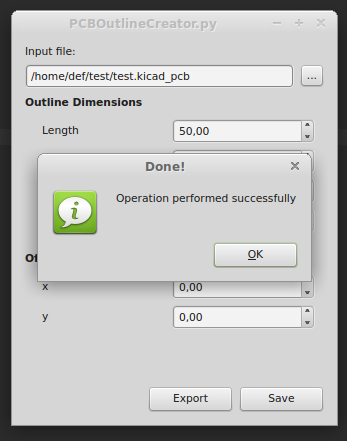Connecting the GUI to the backend
In tutorials 01 to 06 we built a GUI interface and configured it to accept all the required arguments within their allowed ranges. But this application does not perform any action yet. In this tutorial we will learn how to connect the app to the exiting Python module so that we can actually add PCB borders to our Kicad PCB design.
Kicad Outline Module (backend)
This Python module, included in my Kicad-library repository creates a PCB outline of the specified dimensions and writes it on a .kicad_pcb file. The syntax for using this module is very simple:
# Creating a 50x50mm outline with 0.2 line width:
from kicad_board import KicadBoard
board = KicadBoard('file.kicad_pcb')
board.add_rect_outline(50, 50, 0, 0.2)
board.save()
If we want to place the outline at a position different from (0, 0), we can use the following code:
# Creating a outline centered at (100,100)
from kicad_board import KicadBoard
board = KicadBoard('file.kicad_pcb')
board.add_rect_outline_at_point((100, 100), 50, 50, 5, 0.2)
board.save()
In our case we will use the second expression, as it is more generic.
Calling the module from our GUI
The first step, as always, is to import the module that will allow us to perform those actions:
from kicad_board import KicadBoard
Then, we will edit the callback functions onSaveButtonClicked and onExportButtonClicked to call our module. We will use the obtained filename as argument to create a KicadBoard, and the parameters extracted from the interface as arguments to the add_rect_outline_at_point method. For the export button callback we will also use the selected output file path to save the board as a different file.
The code for onSaveButtonClicked will be the following one:
def onSaveButtonClicked(self):
reply = QtGui.QMessageBox.question(parent=self, title='Attention',
text='File will be overwritten.\nDo you still want to proceed?',
buttons=QtGui.QMessageBox.Yes | QtGui.QMessageBox.No,
defaultButton=QtGui.QMessageBox.No)
if reply == QtGui.QMessageBox.Yes:
# Extract values from interface
filename = self.inputFileLineEdit.text()
length = self.lengthSpinBox.value()
width = self.widthSpinBox.value()
line_width = self.lineWidthSpinBox.value()
rounded = self.cornersCheckBox.isChecked()
if rounded:
corners_radius = self.cornersSpinBox.value()
else:
corners_radius = 0
x = self.xSpinBox.value()
y = self.ySpinBox.value()
# Create a KicadBoard
board = KicadBoard(filename)
# Add outline
board.add_rect_outline_at_point((x,y), length, width, corners_radius, line_width)
# Save result
board.save()
For the export button, the code will be similar to the previous one:
def onExportButtonClicked(self):
out_filename, filter = QtGui.QFileDialog.getSaveFileName(parent=self, caption='Select output file', dir='.', filter='Kicad PCB Files (*.kicad_pcb)')
if out_filename:
if '.kicad_pcb' != out_filename[:-10]:
out_filename += '.kicad_pcb'
# Extract values from interface
in_filename = self.inputFileLineEdit.text()
length = self.lengthSpinBox.value()
width = self.widthSpinBox.value()
line_width = self.lineWidthSpinBox.value()
rounded = self.cornersCheckBox.isChecked()
if rounded:
corners_radius = self.cornersSpinBox.value()
else:
corners_radius = 0
x = self.xSpinBox.value()
y = self.ySpinBox.value()
# Create a KicadBoard
board = KicadBoard(in_filename)
# Add outline
board.add_rect_outline_at_point((x,y), length, width, corners_radius, line_width)
# Save result
board.save(out_filename)
Add a notification dialog
It is always a good idea to inform the user that the requested operation has been successfully performed. For that purpose, we can use a PySide predefined dialog to display a simple notification message:
QtGui.QMessageBox.information(self, 'Done!', 'Operation performed successfully', QtGui.QMessageBox.Ok)

Finally, to avoid errors, we have to make sure the input file path lineEdit is not empty. We will check it and inform the user that he must select a file:
filename = self.inputFileLineEdit.text()
if not filename:
QtGui.QMessageBox.warning(self, 'Error', 'No input file was specified!')
return

Complete code
from PySide import QtCore,QtGui
from PySide import QtUiTools
import os, sys
from kicad_board import KicadBoard
def load_ui(file_name, where=None):
"""
Loads a .UI file into the corresponding Qt Python object
:param file_name: UI file path
:param where: Use this parameter to load the UI into an existing class (i.e. to override methods)
:return: loaded UI
"""
# Create a QtLoader
loader = QtUiTools.QUiLoader()
# Open the UI file
ui_file = QtCore.QFile(file_name)
ui_file.open(QtCore.QFile.ReadOnly)
# Load the contents of the file
ui = loader.load(ui_file, where)
# Close the file
ui_file.close()
return ui
class PCBOutlineCreator(QtGui.QWidget):
def __init__(self, parent=None):
QtGui.QWidget.__init__(self, parent)
self.setupUI()
self.resetValues()
def setupUI(self):
# Load UI and set it as main layout
ui_file_path = os.path.join(os.path.realpath(os.path.dirname(__file__)), 'PCBOutlineCreator.ui')
main_widget = load_ui(ui_file_path, self)
layout = QtGui.QVBoxLayout()
layout.addWidget(main_widget)
self.setLayout(layout)
# Get a reference to all required widgets
self.inputFileButton = self.findChild(QtGui.QToolButton, 'inputFileButton')
self.inputFileLineEdit = self.findChild(QtGui.QLineEdit, 'inputFileLineEdit')
self.exportButton = self.findChild(QtGui.QPushButton, 'exportButton')
self.saveButton = self.findChild(QtGui.QPushButton, 'saveButton')
self.lengthSpinBox = self.findChild(QtGui.QDoubleSpinBox, 'lengthSpinBox')
self.widthSpinBox = self.findChild(QtGui.QDoubleSpinBox, 'widthSpinBox')
self.lineWidthSpinBox = self.findChild(QtGui.QDoubleSpinBox, 'lineWidthSpinBox')
self.cornersSpinBox = self.findChild(QtGui.QDoubleSpinBox, 'cornersSpinBox')
self.cornersCheckBox = self.findChild(QtGui.QCheckBox, 'cornersCheckBox')
self.xSpinBox = self.findChild(QtGui.QDoubleSpinBox, 'xSpinBox')
self.ySpinBox = self.findChild(QtGui.QDoubleSpinBox, 'ySpinBox')
# Configure widget ranges:
max_float = sys.float_info.max
self.lengthSpinBox.setMinimum(0)
self.lengthSpinBox.setMaximum(max_float)
self.widthSpinBox.setMinimum(0)
self.widthSpinBox.setMaximum(max_float)
self.lineWidthSpinBox.setMinimum(0)
self.lineWidthSpinBox.setMaximum(max_float)
self.lineWidthSpinBox.setSingleStep(0.1)
self.cornersSpinBox.setMinimum(0)
self.cornersSpinBox.setMaximum(max_float)
self.xSpinBox.setMinimum(-max_float)
self.xSpinBox.setMaximum(max_float)
self.ySpinBox.setMinimum(-max_float)
self.ySpinBox.setMaximum(max_float)
# Connect slots/callbacks and signals
self.cornersSpinBox.setEnabled(False)
self.cornersCheckBox.stateChanged.connect(self.onCornersCheckBoxChangedState)
self.saveButton.clicked.connect(self.onSaveButtonClicked)
self.inputFileButton.clicked.connect(self.onInputFileButtonClicked)
self.exportButton.clicked.connect(self.onExportButtonClicked)
def resetValues(self):
self.lengthSpinBox.setValue(50)
self.widthSpinBox.setValue(50)
self.lineWidthSpinBox.setValue(0.2)
self.cornersCheckBox.setChecked(False)
self.cornersSpinBox.setValue(5)
self.xSpinBox.setValue(0)
self.ySpinBox.setValue(0)
def onCornersCheckBoxChangedState(self, checked):
self.cornersSpinBox.setEnabled(bool(checked))
def onSaveButtonClicked(self):
filename = self.inputFileLineEdit.text()
if not filename:
QtGui.QMessageBox.warning(self, 'Error', 'No input file was specified!')
else:
reply = QtGui.QMessageBox.question(self, 'Attention', 'File will be overwritten.\nDo you still want to proceed?',
QtGui.QMessageBox.Yes | QtGui.QMessageBox.No, QtGui.QMessageBox.No)
if reply == QtGui.QMessageBox.Yes:
# Extract values from interface
filename = self.inputFileLineEdit.text()
length = self.lengthSpinBox.value()
width = self.widthSpinBox.value()
line_width = self.lineWidthSpinBox.value()
rounded = self.cornersCheckBox.isChecked()
if rounded:
corners_radius = self.cornersSpinBox.value()
else:
corners_radius = 0
x = self.xSpinBox.value()
y = self.ySpinBox.value()
# Create a KicadBoard
board = KicadBoard(filename)
# Add outline
board.add_rect_outline_at_point((x,y), length, width, corners_radius, line_width)
# Save result
board.save()
QtGui.QMessageBox.information(self, 'Done!', 'Operation performed successfully')
def onInputFileButtonClicked(self):
filename, filter = QtGui.QFileDialog.getOpenFileName(parent=self, caption='Open file', dir='.', filter='Kicad PCB Files (*.kicad_pcb)')
if filename:
self.inputFileLineEdit.setText(filename)
def onExportButtonClicked(self):
in_filename = self.inputFileLineEdit.text()
if not in_filename:
QtGui.QMessageBox.warning(self, 'Error', 'No input file was specified!')
else:
# Ask for the output filename
out_filename, filter = QtGui.QFileDialog.getSaveFileName(parent=self, caption='Select output file', dir='.', filter='Kicad PCB Files (*.kicad_pcb)')
if out_filename:
if '.kicad_pcb' != out_filename[-10:]:
out_filename += '.kicad_pcb'
# Extract values from interface
length = self.lengthSpinBox.value()
width = self.widthSpinBox.value()
line_width = self.lineWidthSpinBox.value()
rounded = self.cornersCheckBox.isChecked()
if rounded:
corners_radius = self.cornersSpinBox.value()
else:
corners_radius = 0
x = self.xSpinBox.value()
y = self.ySpinBox.value()
# Create a KicadBoard
board = KicadBoard(in_filename)
# Add outline
board.add_rect_outline_at_point((x,y), length, width, corners_radius, line_width)
# Save result
board.save(out_filename)
QtGui.QMessageBox.information(self, 'Done!', 'Operation performed successfully')
if __name__ == '__main__':
# Create Qt app
app = QtGui.QApplication(sys.argv)
# Create the widget and show it
gui = PCBOutlineCreator()
gui.show()
# Run the app
sys.exit(app.exec_())